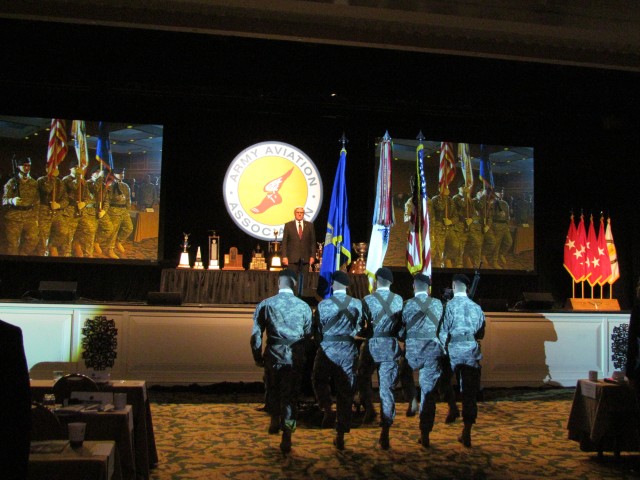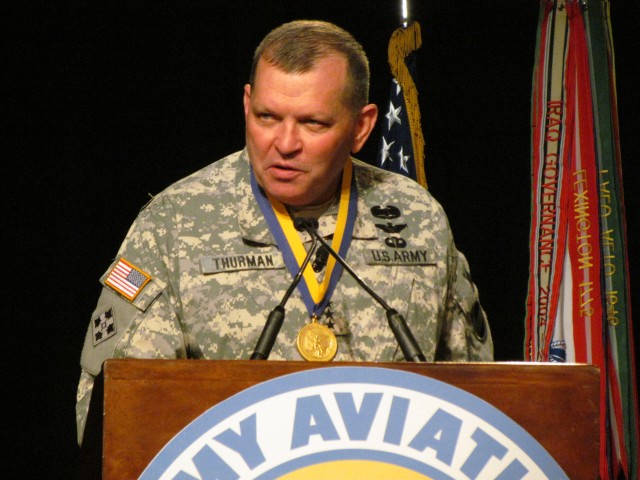REDSTONE ARSENAL, Ala. -- Despite challenges of an aging aviation fleet and the demands of two wars, aviation programs will remain a key component of the Army's focus to win on the battlefield, said one of the Army's leading generals.
Speaking to Soldier aviators, general officers and industry representatives attending the Army Aviation Association of America annual Professional Forum and Exposition at Nashville's Gaylord Opryland Hotel, Gen. James Thurman, commander of the Army Forces Command, said "the Army absolutely remains focused on winning the war today, and Army aviation continues to be a central component of that success. I know we will make Army aviation even more effective in future battles."
Thurman, the keynote speaker at the forum's opening session on April 18, aimed his comments at its theme - "Full Spectrum Aviation: Resilient and Adaptive for the Future Security Environment."
"Our 75,000 aviation Soldiers in the active and reserve components will continue the proud tradition of strength until the enemy is defeated and/or destroyed," he said.
As a senior aviator with 36 years of military service and commander of 80 percent of the military's aviation force, Thurman emphasized the importance of the active Army/National Guard/Reserve aviation team.
"This is the true total aviation force that is making a difference every minute of the day in Iraq, Afghanistan and all around the world," he said. "Their dedicated and meaningful service stands as a personification of Army values."
While aviation is only 7 percent of the total Army budget, "Army aviation is recognized as the key enabler. No matter the enemy or the operation, the commander on the ground always needs more aviation capability," Thurman said. "Aviation is a key ingredient to success on the battlefield."
Since the beginning of the Global War on Terrorism - officially Feb. 1, 2003 - there have been 4.5 million combat hours flown by the Army's aviation fleet. Currently, the Army sustains over 650 helicopters in Afghanistan and Iraq. In addition, 149 helicopters are committed to other parts of the world and 129 helicopters are stationed in the U.S. The Army also has a 350-member fixed wing fleet worldwide.
"No Army in the world can put up the numbers that can even come close to these," Thurman said.
But three issues - continuing high demand for aviation capabilities, the need for continued success after nine years of war and the impact of a reduced operating budget -- must be addressed in the future of Army aviation.
"How do we sustain this force, and sustain not only our people but our platforms'" Thurman asked. "How do we continue to manage and equip for two theaters of war' ... I will do everything in the world to protect our Soldiers and keep them sustained."
The Army will complete the activation of the 12th aviation brigade in 2012 at Joint Base Lewis-McChord, Washington. But the demand for aviation means even more brigades are needed, he said.
"Our aviation Soldiers carry a heavy load with professionalism and enthusiasm," Thurman said. "They do a one-year tour every 15 months when the goal is 24 months at home between deployments. The 10th and the 4th are still deploying with only a year at home. We must equip a 13th combat aviation brigade."
The general touched on the success of the UH-60M model Black Hawk, the requirement for high-altitude mountain environment training for aviation Soldiers deploying to Afghanistan, and the teaming of manned and unmanned aircraft.
He also commented on Army acquisition reform, saying the Army is "working to bring discipline to acquisition programs. We have to field platforms quicker."
Calling on the nation's patriots in both industry and government to work together in developing and procuring new aviation systems, Thurman said "We are in an era of protracted conflict coupled with an era of dwindling budgets ... We must build readiness at best value and we must do that with the constraints imposed by the nation's fiscal situation."
He mentioned the request for a new armed air scout platform to replace the Kiowa Warrior helicopter. The current Kiowa fleet is "flying well over 100 miles per month on this airframe ... All of our airframes are accumulating hours at four to five times the normal rate."
While commanders are demanding more aviation capabilities, Army aviation receives only 21 percent of the Army equipment budget.
"We need better efficiencies and we must work closer together as a team. We need every dollar to achieve the best value," Thurman said.
The opening session of the aviation association's forum, hosted by association president retired Brig. Gen. Rod Wolfe, began with a flag ceremony presented by the Fort Campbell, Ky., color guard, and with a memorial presentation of three Army aviation icons - Lt. Gen. Jack Mackmull, Lt. Gen. Gus Cianciolo and Col. John Stanko Jr. -- who had passed away during 2010. A touching slide show memorial to Army aviators who were killed in combat in 2010 was set to bagpipes played by Joe Ausfahl of Redstone Arsenal.
The association's Tennessee Valley-Huntsville chapter was named the top senior chapter of 2010. With 2,010 members, it is the largest association chapter and has continued to grow with more than 100 new members each year for the past three years.
The session also included a taped message from Maj. Gen. John Campbell, commander of the International Security Assistance Force, Kandahar (Afghanistan) Regional Command South. The command includes 178 airframes, with 110 of those in the air every day.
"They are flying in the most inhospitable terrain and also the most dangerous," Campbell said. "We've had more than 400 incidents of being fired on (during the past 11 months) and we've had 80 airframes damaged. We've conducted thousands of air assaults, a total of 132 since March. The Apache remains one of the most lethal killers.
"Heroism abounds throughout the aviation brigades ... Aviation is doing a magnificent job here. I see every day how aviators truly make the remarkable look routine. Helicopters and crews are at high demand. We need more Army aviation ... Our aviators are making a significant impact every day."
Campbell showed the audience numerous cards that carry the names and pictures of Soldiers who have died in Afghanistan. He takes the cards from his pocket often to reflect on the nation's and the Army's loss.
"I will never ever forget their great sacrifice ... Our aviators put it on the line every single day here in Afghanistan," he said. "We can never forget the sacrifice of these great Soldiers. Air assault!"
Maj. Gen. Anthony Crutchfield, commanding general of the Army's Aviation Center of Excellence and Fort Rucker, also spoke at the opening session, expressing his dismay and sorrow over the loss of Soldiers in the fight. Mentioning the opening session's memorial of fallen Soldiers, he said he often asks himself "Am I doing everything I can today to make sure there is no slide show next year at Quad A with pictures of those who were killed'"
Toward that end, Crutchfield said he is working to ensure Army aviation is "adaptive enough, resilient enough to face the enemy of the future. What lies beyond the horizon of Iraq and Afghanistan' What about the future security environment' ... The enemy will adapt to us and we must do the same."
Army aviation has been drawn into the fight to handle a multitude of missions. After a decade of combat, Crutchfield said "aviation Soldiers and equipment are tired ...
"But, I'm not worried about today's commitment. We have that. I'm worried about tomorrow's commitment and resiliency ... What are we doing to train, adapt and equip that future force'"
As a combat enabler, Army aviation is in high demand and will not diminish in the future, he said. There are currently six aviation brigades - representing 623 airframes - deployed in Afghanistan (three), Iraq (two) and Korea (one). Fifty percent of aviation missions are in support of special operations.
"That's high demand in a fluid environment. That's why resiliency and adaptability are so important," Crutchfield said.
The challenge for the future is developing leaders and modernizing airframe platforms.
"We've got to continue to build leaders that are adaptive, both tactically and strategically, so they can lead in an unclear, complex, uncertain environment," Crutchfield said.
The two-star general said the need to modernize the fleet is imperative to the future of Army aviation.
"The current fleet, although great aircraft, will someday be obsolete. We have to have a method of looking out into the future to ensure we have aircraft relevant to the fight," he said.
Fiscal year 2025 is the year that Kiowa Warrior is supposed to be phased out of the Army's helicopter fleet. Fiscal year 2035 is the end year for Black Hawks and Chinooks. And fiscal year 2040 will bring an ending to the Apache Longbow program.
"Technology will change. We've got to be resourced to take advantage of technology so that we can be integrators and outcome based," Crutchfield said. "The future vertical lift airframes have to increase range, speed, payload and survivability, and reduce the logistical footprint ... 2035 is the aim point. We're not going to get everything we want. But we have to get everything we need."
If it hadn't been for the visionaries of the 1960s and '70s, Army aviation wouldn't be as strong as it is today, Crutchfield said. His hope is that the visionaries and leaders of today will leave the legacy of a "healthy aviation branch postured for full spectrum operations in defense of our national interests and our nation."




Social Sharing